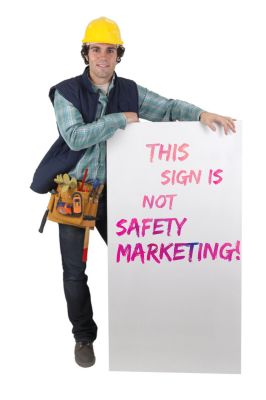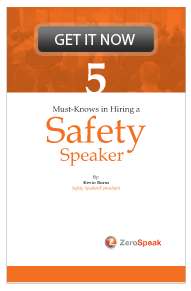Safety marketing is what creates value and motivates people to action.
 In the summer of 1974, a tractor in a rocky field was cutting the soil and dropping 200-foot long lines of copper wire in the ground. When completed, there were five miles of 200-foot sections spreading out like a spider web. At the center of the wire web was a radio broadcast tower. The copper wire strands connected to the base of the tower grounded and dissipated energy from potential lightning strikes. This was my Dad’s radio broadcast tower in our hometown.
In the summer of 1974, a tractor in a rocky field was cutting the soil and dropping 200-foot long lines of copper wire in the ground. When completed, there were five miles of 200-foot sections spreading out like a spider web. At the center of the wire web was a radio broadcast tower. The copper wire strands connected to the base of the tower grounded and dissipated energy from potential lightning strikes. This was my Dad’s radio broadcast tower in our hometown.
I learned a lot of things about both marketing and communications in that first year the radio station went on the air, especially the difference between marketing and communications. The simplified version is this: if you’re listening to the news, the weather or a talk-show on the radio, that’s communications. If you’re listening to a commercial, a contest or an on-location broadcast, that’s marketing.
Communications inform. Marketing moves you to an action. And this is where most safety programs make their biggest mistake. They assume that informing (communications) is enough. But it isn’t.
PowerPoint slides, inspection reports and incident reviews are information (communications). Statistics, lagging indicators and white papers are information (communications). But none of them move people to take an action. It is information; nice to have and good to know. And although this information may influence your decision (or not) to take an action, in and of itself it does not move people.
We need to create a safety marketing plan that motivates employees. Marketing moves people forward. It’s a spur to action that takes people from where they are to someplace better. Marketing goes beyond simply informing. It’s the next stage of communication. Marketing makes a compelling case for “why” employees should choose to take a new action for safety.
Simply put, marketing is what creates value and motivates people to action. I have two full chapters dedicated to safety marketing including a step-by-step of how to put together a safety marketing plan in my book PeopleWork: The Human Touch in Workplace Safety.
Meanwhile, here are three strategies to improve your safety marketing effectiveness:
1Think hearts and minds. Safety has traditionally focused on appealing only to minds and not hearts. This is why safety buy-in meets resistance: there’s been no establishment of value for the employee. Many safety people think that safety should sell itself—that people should buy-in because it’s the right thing to do. But we know that people don’t always do the right thing. They smoke cigarettes, text while driving, drink to excess, and overeat. People sometimes need a little convincing to make changes in their own best interests. That’s safety marketing. Hammering on safety rules won’t sell people on safety. But answer the “why” of safety and you start appealing to hearts as well as minds.
2Establish their win. Most of the emotional appeal of traditional safety warnings is focused on creating a negative emotion, including sad stories of injury on the job. Gruesome photos of dismemberment create emotion, yes—but not the kind that moves people toward something. As a supervisor or safety person, you need to know the positive aspects of safety, the benefits of doing safety right and, the win-win of buying-in to the safety program. Establish value for employees. Find the win in safety for each of your people with an answer to “what’s in it for me.”
3Safety is about people being valued. Most employees want to feel valued for the work they do. They want to feel like their work means something and that their contributions are important. They want to feel protected by their employers and respected by their co-workers and supervisors. In a nutshell, people want to feel proud of what they do and how they do it. Supervisors and safety people must re-frame how they market safety to employees. They must do it in a way that shows employees that safety and caring for people gives them exactly what they want.
 Marketing builds on positives, not negatives. Successful marketing creates a bond between the seller and buyer. Safety isn’t an add-on. It’s the foundation on which an organization is built. Safety needs to become one of the core values of a company alongside accountability, responsibility, and integrity. That’s why safety marketing can’t just focus on safety. It shouldn’t just change safety culture, it should change corporate culture. It needs to be integrated into all aspects of the company to become one of the foundational values of an organization.
Marketing builds on positives, not negatives. Successful marketing creates a bond between the seller and buyer. Safety isn’t an add-on. It’s the foundation on which an organization is built. Safety needs to become one of the core values of a company alongside accountability, responsibility, and integrity. That’s why safety marketing can’t just focus on safety. It shouldn’t just change safety culture, it should change corporate culture. It needs to be integrated into all aspects of the company to become one of the foundational values of an organization.
Safety needs to take a lesson from basic marketing: What gets focused on gets talked about, and what gets talked about gets attention.
Kevin Burns has authored ten books on human performance and safety, including his most recent release, PeopleWork - The Human Touch in Workplace Safety. Buy it now on Amazon. Then, consider bringing Kevin's consulting expertise to your company or have him speak at a safety event.
©2017 ZeroSpeak Corporation and Kevin Burns.
No part of this post may be reproduced without the expressed consent of the author.


